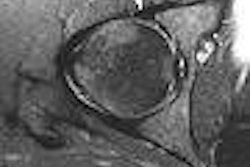Clinical Magnetic Resonance Imaging - Volume 1 by Robert R. Edelman, John R. Hesselink, Michael B. Zlatkin, and John V. Crues, III, 3rd ed.
Elsevier Health, St. Louis, MO, 2006, $579
This third edition is a monumental step forward in its physical size and the scope of material. It's designed to be clinically useful and discuss current research and future potential. This behemoth of a book manages both tasks admirably.
Volume one consists of more than 1,000 pages. It's divided into one very complete, but dauntingly large section, of 26 chapters on physics, instrumentation, and advanced techniques. A smaller section of a dozen chapters covers the heart and vascular system.
One notable feature of the first chapter is the photographs of many of the people involved in the evolution and development of MRI. This detail provides perspective for the remainder of the series.
Topics covered in this section include basic principles, pulse sequence design, and artifacts and solutions. The space devoted to newer research and techniques, such as molecular and cellular imaging and diffusion tensor MRI fundamentals, is surprising but not unwelcome.
The smaller section on the heart and vascular system covers the basic principles of MR angiography, 3D MRA, and flow quantification, to name a few topics. There are also chapters on MR venography, perfusion imaging, and pediatric heart disease.
The authors and contributors to this volume are leaders in their field. Dr. Raymond Kim at Duke University in Durham, NC, contributes an excellent chapter on delayed enhancement imaging for myocardial viability, a field that he pioneered. This technique grows in popularity and is now often used to evaluate arrythmogenic right ventricular dysplasia.
A second outstanding chapter on adult heart disease, by Drs. Arthur Stillman and Richard White at the Cleveland Clinic in Ohio, clearly describes and illustrates pericardial diseases, cardiomyopathies, infiltrative diseases, and cardiac masses.
Other major strengths of this volume are the comprehensive and up-to-date references at the end of each chapter and the large number of excellent figures, tables, and boxes.
Minor drawbacks stem primarily from the number of contributors to this text, which does lead to content redundancy, especially when more advanced principles are discussed. Two chapters aim to cover the business of an MRI center, but provide insufficient information.
On the whole, volume one of Clinical Magnetic Resonance Imaging is an excellent text that will prove invaluable for radiologists who wish to learn about the most up-to-date clinical techniques. It also provides an enlightening read for those who are interested in the scientific underpinnings of this modality and its future directions.
By Dr. Danny Donovan
AuntMinnie.com contributing writer
February 14, 2006
Dr. Donovan is currently a fellow in cardiovascular imaging at Stanford University in Stanford, CA.
The opinions expressed in this review are those of the author, and do not necessarily reflect the views of AuntMinnie.com.
Related Reading
Clinical Magnetic Resonance Imaging - Volume 2, February 14, 2006
Clinical Magnetic Resonance Imaging - Volume 3, February 14, 2006
Copyright © 2006 AuntMinnie.com



.fFmgij6Hin.png?auto=compress%2Cformat&fit=crop&h=100&q=70&w=100)




.fFmgij6Hin.png?auto=compress%2Cformat&fit=crop&h=167&q=70&w=250)











